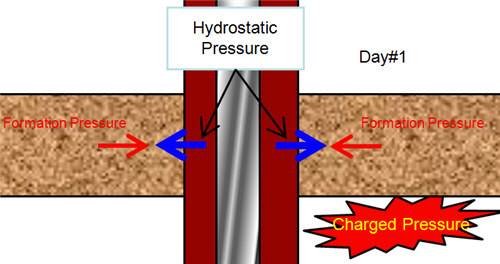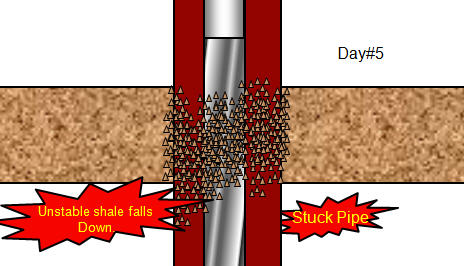Hydro-pressured shale is a common problem in some area and it could cause stuck pipe.
How does it happen?
With mud weight in the wellbore higher than formation pressure, pore pressure of shale is always charged by hydrostatic pressure from drilling mud.

(Charged pressure due to hydrostatic pressure)
When the well has been drilled for a period of time, shale formations become unstable due to charged pressure and finally shale breaks apart and falls down into the hole. 
(Shale becomes unstable.)
Finally, a drill string gets stuck due to hydro-pressured shale which accumulates in the annulus.

(Pipe becomes stuck by unstable shale)
This process is time dependent like shale instability. It may take days before the stuck pipe situation will be occurred.
Warning signs of hydro-pressured shale
• Torque and drag increase.
• Over pull may be observed.
• Observe shale caving on shale shakers
Indications when you stuck due to hydro-pressured shale
• When it happens, the hole will be either partially bridge off or packed off; therefore, circulate is restricted or impossible in some cases.
• It could be happened while tripping and drilling.
What should you do for this situation?
1. Attempt to circulate with low pressure (300-400 psi). Do not use high pump pressure because the annulus will be packed harder and you will not be able to free the pipe anymore.
2. If you are drilling or POOH, apply maximum allowable torque and jar down with maximum trip load.
3. If you are tripping in hole, jar up with maximum trip load without applying any torque.
4. Attempt until pipe free and circulate to clean wellbore.
Preventive actions:
1. Use oil based mud instead of water based mud because oil will not react with shale.
2. Minimize surge pressure and equivalent circulating density (ECD) in the wellbore.
3. Keep mud properties in good shape. Avoid drilling and circulating with thick mud because it creates additional surge pressure.
Reference book: Trouble-Free Drilling Volume 1: Stuck Pipe Prevention














No comments:
Post a Comment